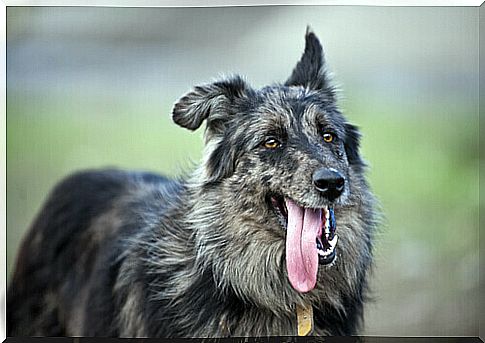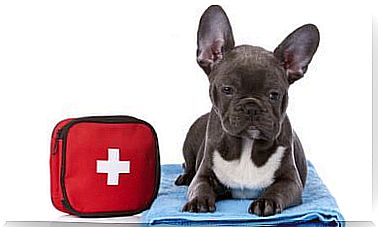How Dogs Sweat And How They Regulate Their Temperature

If you’ve always wondered how dogs sweat, the answer is truly amazing. These magnificent animals exploit a series of special glands, but not distributed throughout the body. Sweat is mostly released through the pads of the paws. Without forgetting their ability to expel heat from the mouth and tongue.
A series of mechanisms that allow dogs to manage heat. By doing so, they are able to keep their body temperature always optimal and constant. Let’s see how dog sweating works.
How Do Dogs Sweat? The secret is in the bearings

Unlike us humans, who expel water and water vapor through the pores of the skin, canids have a more concentrated mechanism. In the lower part of the legs, or in the pads, there are sweat glands. Protected by a layer of fat, which acts as an insulator, they allow sweat to escape, while the excess heat is exhaled through breathing.
The operation of this natural cooling system is both simple and effective. In the presence of an increase in temperature, the organism instructs the glands to open, allowing the exchange of heat with the soil and the external environment.
Another component of the temperature management system is the ears. By dilating and expanding, they too contribute to the dispersion of heat.
There is therefore no massive sweating all over the body, as happens in humans. Through these three specific channels (pads, mouth and ears) each dog is able to lower the overall body temperature, bringing it back to normal values.
Warmth and hydration in dogs
We have shown you, in broad terms, how dogs sweat. It must be said, however, that despite the effectiveness of these systems, it is possible to facilitate their work by ensuring the right hydration to the animal. Especially during the warm months, it is a good idea to offer your dog large quantities of fresh water. A way to safeguard his health and allow him to endure, in a less traumatic way, the sun and the high temperatures of the season.
Its normal temperature varies between 38 and 39 degrees. When excess heat is detected, the heart pumps blood towards the tongue. On its surface there are myriads of glands that have the ability to open faster than those on the pads. Therefore, by keeping the mouth open, the continued dilation of the glands of the tongue allow the release of water vapor and moisture.
This explains why, in the summer or after a long run, your pet remains stationary with its tongue well exposed to the air and dangling. A dog’s organism works like a refrigerator. The heat that comes from the lungs, circulating on the palate, mouth and tongue, cools. The droplets escape and fall to the ground, allowing the animal to considerably lower its temperature.
Big dogs sweat less
As can be easily understood, larger dogs have greater difficulty in expelling heat. Compared to specimens of reduced tonnage, in fact, they sweat less. Since they have larger bones, muscles and organs, their bodies will always generate more heat than they can release.
The advantage of small dogs comes from the fact that they are able to respond better, and faster, to the increase in ambient temperature. These represent a real danger for animals, which can suffer from heat stroke, even lethal, if not protected and adequately hydrated.
Beware of heatstroke
This is probably the greatest danger for dogs of considerable size. By “heat stroke” we mean an increase in the animal’s body temperature over 42 degrees. The negative consequences of such a situation can be very serious. However, they will depend on the maximum level of temperature reached and on the period of time during which the dog has suffered from it.
Statistically, most heatstroke occurs in cars. If you are traveling under the scorching sun with your four-legged friend in the car, you will have to follow some precautions. Open the windows, allow a constant exchange of fresh air and, when necessary, activate the air conditioning system. The goal is to prevent the dog from suffering at all costs.
Avoid leaving your pet alone in the car. On particularly hot days, due to the color of the car and the asphalt, a few minutes are enough to bring the internal temperature to dangerously high levels. If you really can’t avoid doing so, park in a garage or in the shade, always leaving the vehicle windows wide open.
Symptoms of heat stroke
If you are worried about heatstroke, you need to look out for a number of obvious symptoms:
- Impaired breathing
- Tachycardia
- High body temperature
- Mucosal congestion
- Vomiting, diarrhea
- Shock or loss of consciousness (in rare cases).
In the presence of one or more signals of this type, there is only one thing to do. Go to a veterinary clinic urgently or notify your veterinarian. In the meantime, you can put the animal in the shade, in a cool, ventilated place and wet it with water. If the animal remains conscious, try making him drink small amounts of fresh water.
This explains how dogs sweat

After several years of study, scientists have discovered that the dogs’ thermoregulatory system works like a modern thermostat. In the presence of any rise in temperature, the warmer blood is sent to the head area.
About 75% of the heat is released from the mouth, tongue and ears. Breathing changes and becomes very rapid, almost panting, but less deep. As hot air flows from the trachea to the tongue, the exchange with the fresh air molecules completes the process, returning the cooled blood to the brain.
An almost foolproof system that, when it gets too hot, you have a responsibility to help by providing shade, ventilation and plenty of water for your best friend.








